After my experiences with the Cetus in the second half of 2009, it's about time now to describe some technical details about her before finishing my testperiod with the Cetus.
The hull
The Cetus has a rather rounded underwatership with flat midsection and a sharp bow. Furthermore the hull is given a swedeform shape which helps making it a fast kayak.
Deck layout

The decklines are not very thick, but thick enough. They start and end close to the cockpit: also aside of the day-compartment, which is rather remarkable as most modern kayaks have the decklines never aside of the hatch. This feature gives full access to decklines in whatever situation and wherever you grab for lines. :-)
Elastic shockcords are available at the required places.
And, very tidy, the toggles are held in position by a shockcord; standard!
The compass is recessed nicely in the deck just before the front-hatch. This position is nowadays rather common, but for me as wearer of glasses a bit more close by is welcome.
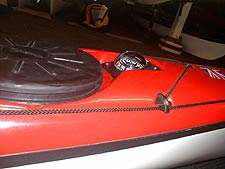
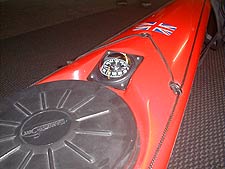
The fourth hatch is handy for direct access during trips. But it has also consequences as described below under "cockpit".
The hatches are round and big enough to put your head (mine fits) inside.
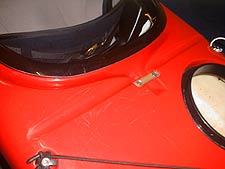
Just behind the cockpit P&H constructed, as on most of there other kayaks, a groove wherein your paddle-shaft fits to form a paddlebridge.
Cockpit
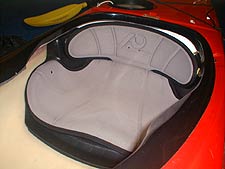
The seat is very comfortable and has a separate liner offering some isolation and elasticity.
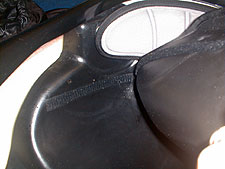
One drawback is that after some time this liner moves a little while edging the kayak. This can be fixed with some velcro like on the picture left.
When you like perfect hip-contact and your hips are not wide enough to contact the seat, you will have to do some creative work to make the seat a bit narrower. May be it is possible to add some filling underneath of the seat-liner next to your hips. Remember it is important to have good hip-contact in a large kayak like this.
Because the seat is positioned quite aft in the cockpit and the deck being rather high, it is not easy to do a layback while rolling.
The knee grips are comfortable and provide good grip and control over the kayak. It is however advised to improve the grip by adding a thin layer of foam like you sea underneath:
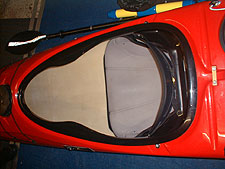
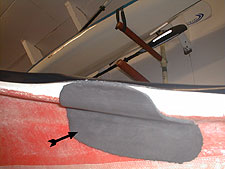
Furthermore the cockpit is, with its 87 x 51cm, big enough for easy entrance and exit.

The footrests are easily adjustable even when seated by means of a stick you can turn. They are more comfortable than the former (type J&R) small adjustable footrests because now the surface, where your feet rest, is much bigger which results in better spreading out of the forces on your feet.
As I had the experience that one footrests moved by itself out of reach of my foot, I would like to advice to check always if you locked them properly. My fault was, may be, having done the locking wrong.
When you want to install a foot-operated pump inside the cockpit, the bad news is that this will be impossible once the kayak is ready: the 4th-compartment, just in front of the cockpit, makes it impossible to work inside the cockpit. You will have to order your Cetus with a factory installed footpump on a front bulkhead positioned at your leg-length
But be aware: When you have rather short legs there is a chance that you will not be able to operate the pump because the compartment prevents to move one feet behind it. But also when you have longer legs be careful in your decisions.
Variable skeg
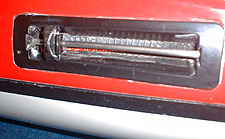
The skeg is operated by a newly developed system which makes the system not vulnerable anymore to cable-cinking when you forget to retract the skeg while landing.
The natural position of the skeg-blade is down: lowered by means of an elastic shock-cord pulling at it all the time. The skeg-blade position is operated by a rope from a system where the operating button is locked by a rattle-device and a pinching button.
The operating if the skeg is not that simple. OK, of course you have to get used to the different way of operating: first squeeze the button and move it. But that is not the problem: sometimes you have to squeeze too hard and then it is hard to move the button. This was the case with both Cetus' in the club. On internet you can find a lot of comments on this. Having read some I understood that it could well be that it has something to do with the rope-material.
Some stories report perfect operation after replacement by P&H. Others are less lucky.
As P&H uses this system on other kayaks as well its not a specific Cetus-problem. May be this helps P&H in finding quickly a good solution for everyone.
Furthermore I observed that the skegblade is very flexible; may be too flexible. I would like to refer to my experiences in following waves where a bigger skeg blade or else may be a stiffer blade could improve the kayaks performance.
Quality
I can be very short here: Quality is outstanding.
Compartments
When you look at the total volume of the Cetus, you know it already: this is a kayak with an big capacity for carrying loads
As you know watertight compartments are vulnerable for over- and under pressure because of temperature changes. Until now kayakkers drill small holes in the bulkheads to normalise the pressure in the compartment.
In the Cetus P&H finally introduced another solution for this problem:
pressure valves.
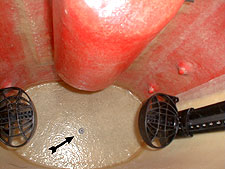
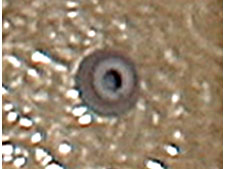
I was not able to test the functioning of them, but I certainly embrace the idea. Maybe you, reader and Cetus owner, can add your experiences.
Dimensions & size
Length: 17’10” # 5,43m
Max. Width: 22.5" # 57 cm
Max Deck Height: 12.2" # 31 cm (front coaming)
Total volume: 100 gal. # 379 litre
Cockpit: 34.25"x20" # 87 x 51 cm
Material/weight:
- Carbon/Kevlar # Weight: 57lbs # 25,9 kg
- fiberglass/diolen # Weight: 64lbs # 29 kg
Optimum Total Load (approx.): 143-297 lbs # 65-135 kg
